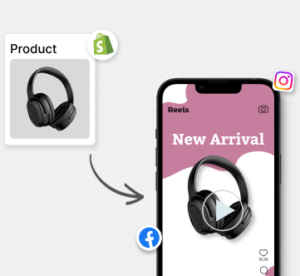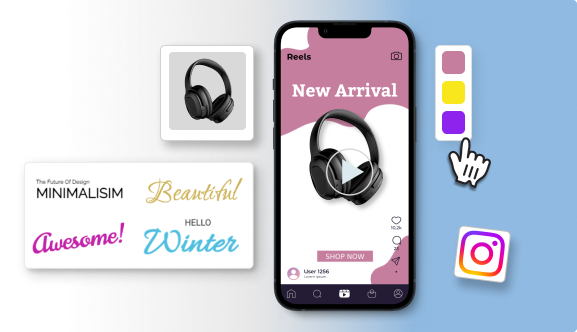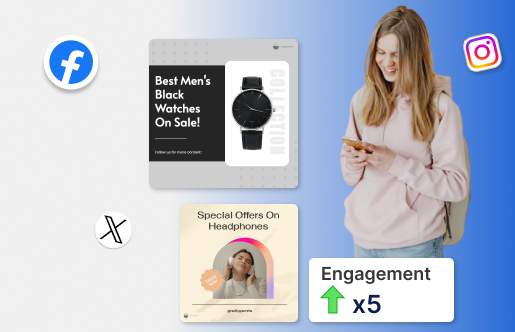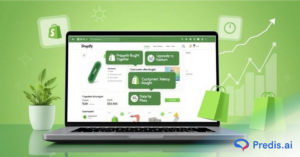In the digital marketing environment, Instagram has established itself as the dominant platform for businesses to connect with their target market, develop brand recognition, and generate revenue. With more than a billion monthly active users and a vibrant community, Instagram provides unrivaled opportunities for businesses to display their products and services in visually appealing and interactive ways.
Out of all the features available on Instagram, the product catalog stands out as one of them that proves beneficial, especially to e-commerce companies that want to show what they sell, hence making it easier for customers to buy. However, creating an effective Instagram catalog is not just about uploading pictures of your products accompanied by descriptions. It requires strategic thinking that integrates imagination, branding, user experience, and data-driven insights to captivate viewers and influence conversions.
All components involved when you design Instagram product catalog, such as high-quality imagery, clear labels, storytelling approach used, or interactive sections, make up part of strategies aimed at achieving high interest rates, hence attaining sales-focused catalogs.
Understanding the Importance of Instagram Product Catalog
When you design Instagram product catalog, you should first understand why it is extremely important to have one for any business, particularly in the e-commerce industry. Here are some key reasons:
- Better Shopping Experience: This means that the users get to experience a shopping spree on Instagram without having to go through other websites.
- Higher Discoverability: If you tag products on your posts and stories, customers will find it easier to see your items, leading to conversions in the process.
- More Engagement: Such visual quality, along with interactive elements like product tags as well as “shoppable” posts, can greatly boost engagement with your brand.
- Drive Sales: Eventually, an appealing and accessible way of showing off your products is what underlies Instagram’s product catalogs.
Key Elements of an Effective Instagram Product Catalog
Now that we’ve established the significance of Instagram product catalogs, let’s understand the key elements that make them effective:
- High-Resolution Visuals: Any successful Instagram product catalog is built on compelling visuals. Invest in professional photography or use high-resolution images that showcase your products in their best light.
- Consistent Branding: To reinforce brand recognition, maintain a consistent visual identity in your catalog. This means using consistent colors, fonts, and imagery that reflects your brand’s aesthetic.
- Clear Product Descriptions: Each product should have concise yet informative descriptions that include the main features, benefits, and specifications. Language should be used which resonates with the target audience and incites them to take action.
- Product Tags and Links: Take advantage of Instagram’s tagging feature and allow users to shop for your products. Tag products directly into posts or stories so that customers can be led to product pages where they can buy seamlessly.
- User-Generated Content: Make sure you add user-generated content (UGC) to your product catalog to make it more authentic and social proof. Ask your customers to share photos and reviews about your products, and then put these in strategic places in the catalogs.
- Regular Updates: Keep your product catalog fresh and up-to-date by regularly adding new products, refreshing content, and responding to customer feedback.
Strategies for Designing a Stellar Instagram Product Catalog
To ensure your Instagram product catalog stands out from the crowd and effectively drives engagement and sales, consider implementing the following strategies:
Narrate with Your Products
Instead of just displaying your products, you can use your Instagram product catalog to tell a story that your viewers will be able to connect with. Include lifestyle imagery and narratives that emphasize the benefits and uses for your goods, which makes them more appealing.
Use Videos
In addition to static photos, include video content in your Instagram product catalogs. This helps to create a better immersive experience for your audiences. Generate briefs for demonstrating products, behind-the-scenes footage, or user testimonials that display your products.
Check out Predis.ai's Instagram reel maker for creating engaging reels for your products!
Mobile Optimization
Due to most people who are using Instagram accessing it with their mobile phones, it is very important for you to optimize even the product catalog for mobile viewing. Make sure that images and videos are optimized for all device screens.
Try Different Formats
Experiment with different formats and layouts for your Instagram product catalog. Try carousel posts with several pictures or videos displayed in the same post. Alternatively, Instagram Stories let you present your products more fleetingly.
Respond to Your Audience
Use your Instagram product catalog to reach out to your audience and create relationships with them. Encourage feedback, answer comments and messages quickly, and use user-generated content to grow a brand community.
Work with Influencers
If you want to increase the coverage of your Instagram product catalog, consider partnering with influencers and content creators. Identify influencers within your niche who share common values with your brand. Collaborate with them on creating real-life, engaging content that highlights your products.
Monitor Performance Metrics
To evaluate the efficiency of an Instagram product catalog, watch important performance metrics such as engagement rate, click-through rate, conversion rate, etc. Use this information to develop an improved strategy, enhance the quality of posts, and identify growth possibilities.
Real-World Examples of Effective Instagram Product Catalogs
Let’s take a look at some real-world examples of brands that have mastered how to design Instagram product catalog:
- Nike: Nike is a well-known athletic apparel and footwear brand that excels in the art of using visually striking imagery and interesting stories to display its products. This company’s Instagram feed, which is targeted at athletes and fitness enthusiasts, combines product shots with energetic visuals.
- Sephora: This beauty store chain uses Instagram catalogs to advertise its range of make-up, skincare, and fragrance items. The catalog contains high-quality photos of products placed on different backgrounds to help their audience gain insights from it.
- Glossier: Glossier’s minimalist design aesthetics are reflected in its Instagram product catalog, where it shares images that depict simplicity as an ideal aspect. The page has different posts about Glossier skincare and make-up products or posts made by customers themselves.
- Etsy: Etsy utilizes Instagram product catalogs to help people understand how artistic its sellers are compared to any other mass production platform. The pictures posted in Etsy’s feed vary greatly from one another; they may be pieces of handmade jewelry as well as handmade paintings that display the individuality or genuineness of every item sold there.
- Warby Parker: The eyewear brand Warby Parker uses Instagram product catalogs to showcase its stylish glasses and sunglasses. Their feed features a mix of product shots, lifestyle imagery, and user-generated content, creating a cohesive and aspirational brand aesthetic.
Maximizing Engagement and Conversions
While creating an aesthetically pleasing Instagram product catalog is crucial, it’s equally important to focus on maximizing engagement and conversions. Here are some strategies to achieve this:
Call-to-Action (CTA)
Use straightforward and irresistible calls to action in your catalog on Instagram. This encourages users to do the next thing: shop now, get more information, or sign up. Add action verbs and position CTA strategically so that customers can buy your products.
Limited-time Offers and Promotions
Foster a feeling of urgency and exclusivity by integrating limited-time offers, promotions, and discounts. Use flash sales, countdown timers as well as promotion codes for promoting immediate action while increasing conversion rates.
Instagram Shopping Features
Take advantage of the many shopping features on Instagram, like having a product tag on stories, a Shop tab, and an Explore channel for shopping to make your products more visible and accessible. Make it easy for visitors to browse through your Instagram product catalog and shop from there directly.
Social Proof and Reviews
Gain trust from people who will be purchasing by adding customer reviews, testimonials, and ratings to your Instagram product catalogs. Use positive endorsements or user-generated content, which will mitigate any fears prospective clients may have about a company’s credibility.
Personalization and Recommendations
Use data about the behavior and preferences of users to personalize content and suggestions in your Instagram product catalog. Employ dynamic product ads, personalized product recommendations, and targeted messaging to provide tailored shopping experiences that resonate with individual customers.
Cross-Promotion and Partnerships
To grow together with your business partners, cross-promote each other’s products among complementary brands while developing partnerships with others. Identifying like-minded influencers or brands can expose your products to new markets in order to create room for mutual growth as well as exposure.
Measuring Success and Iterating
Once you have launched your product catalog via Instagram, it is important to measure essential metrics and analyze performance so that you can ascertain its effectiveness and make informed business decisions in the future. Here are a few key ones:
- Engagement Rate: Consider engagement rates on posts, which include likes, comments, shares, plus saves, to establish how well the content is resonating with users.
- Click-Through Rate (CTR): Take note of CTR for your product tags as well as links to determine if the catalog has been able to draw traffic to your site and result in sales for your company.
- Conversion Rate: Track purchases or inquiries about your catalog that were made through Instagram only.
- Follower Growth: Monitor how quickly your followership is growing in order to determine whether or not this tool is drawing new supporters while expanding your market reach.
- Audience Insights: Use analytics tools provided by Instagram in order to get insights about the demographics, preferences, and behaviors of people who follow you; then align your content with those needs.
Iterating on this analysis and refining your Instagram product catalog strategy results in better performance toward meeting marketing objectives. Also, try to experiment with different content formats, posting schedules, and engagement tactics to keep your audience engaged and drive sustained growth.
Boost Sales on Social Media with AI ⚡️
TRY NOWFinal Thoughts
To design Instagram product catalog that’s effective, you need careful planning, attention to detail, and creativity. By incorporating high-quality visuals, consistent branding, clear product descriptions, and interactive features, you can create a catalog that engages your audience and drives sales. Draw inspiration from leading brands to take your Instagram marketing efforts to the next level.
So why wait? Unleash your creativity with Predis.ai and start designing a captivating Instagram product catalog that showcases your brand and products in the best possible light.
Related Content,




















